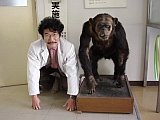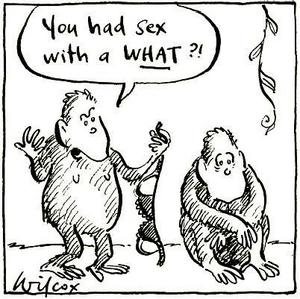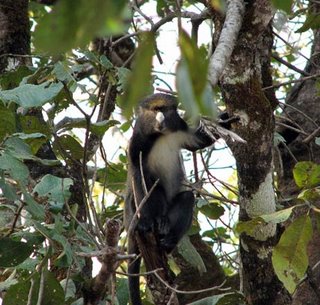
Chimps And Human Speciation Was Messy According To DNA Analysis
This article is very troubling.
I've put in red the bit that got me chuckling with a kind of horror.
"For the first time, we're able to see the details written out in the DNA," said Eric Lander, one of the collaborators on the study. "What they tell us at the least is that the human-chimp speciation was very unusual."
Unusual, indeed. The researchers, from the Broad Institute of MIT and Harvard, propose that humans and chimpanzees first split up about 10 million years ago. Then, after evolving in different directions for about 4 million years, they got back together for a brief fling that produced a third, hybrid population with characteristics of both lines.
That genetic collaboration then gave rise to two separate branches — one leading to humans and the other to chimps.
The work has inspired both admiration and skepticism. Many paleontologists have a hard time believing some of the humans that are known to have lived during that era could have been pairing up with apes.
"It's a totally cool and extremely clever analysis," said Daniel Lieberman, a professor of biological anthropology at Harvard who wasn't involved in the study. "My problem is imagining what it would be like to have a bipedal hominid and a chimpanzee viewing each other as appropriate mates — not to put it too crudely."
The research is the latest fruit of the Human Genome Initiative, the effort to transcribe and read out the entire genetic message of human chromosomes, which was completed in 2003.
Humans have 23 pairs of chromosomes that contain about 30,000 genes. Each gene is made of strands of DNA "letters" in a specific order, and the letters can change, by mutation, over time. The rate at which changes occur is fairly constant and very slow.
The number of DNA differences between two species' versions of the same gene is an indication of how long the species have been separate — or not interbreeding and sharing genes.
When the scientists at the Broad Institute compared the genes of humans and chimps, they found one of the chromosomes — the female sex chromosome known as X — was 1.2 million years younger than the others. It appeared the two species shared a common ancestor who gave them their X chromosomes and did so more recently than the ancestors who gave them the other chromosomes.
The best explanation for this, the scientists think, is that ancient humans and chimps broke away from each other not once, but twice. The first time was more than 6.3 million years ago. The second time was at least a million years later.
What probably happened was some of the evolving human ancestors bred with evolving chimpanzees. This was perhaps not as weird as it seems, for though there were some physical differences between the two groups, "the early humans must have looked pretty much like chimpanzees," said James Mallet, a geneticist at University College in London not involved in the new research.

The horror, the horror. It just feels *wrong*.
But now that I think about it, there's a human population out there that fuck sheep; why not chimps?
Monkeys Talk In Full Sentences
 Here's the article.
Here's the article.Putty-nosed monkeys put two different alarm calls together to create urgent warnings, according to observations recently made of the West African primates.Which is amazing because I've met humans who couldn't do exactly that. Some of them were in charge of science and space policy in Australia! :)
These monkey "sentences" appear to be evidence of what is widely considered to be a uniquely human ability: stringing words together to convey a message, or syntax.
"These monkeys combine different calls into more complex call sequences with novel meanings," said Klaus Zuberbühler, a psychology researcher at the University of St. Andrews in Scotland.
Zuberbühler co-wrote a study about the monkey calls appearing in tomorrow's issue of the journal Nature.
He and co-author Kate Arnold do not make a direct analogy between the monkeys' call sequences and human language. (Read related news: "Monkeys Deaf to Complex Communication, Study Says" [2004].)
But Zuberbühler said that their work shows that "the main carriers of meaning are not the individual calls, but the call sequence."
Monkey "Sentence"
Putty-nosed monkeys belong to a group of African monkeys called guenons. The species' most obvious distinguishing feature, and the one the animals are named for, is a bright white nose that stands out against a brown face.
The monkeys are found throughout the Ivory Coast (map of the Côte D'Ivoire), in parts of Liberia, and along the entire northwest coast of the Congo River.
Groups consisting of a single male accompanying 12 to 30 females and their offspring defend territories within this range.
Like other guenons, putty-nosed monkeys use two loud calls, usually referred to as "pyows" and "hacks." They use a series of pyows to warn of a leopard threatening the group and a string of hacks to indicate the presence of crowned eagles.
Zuberbühler and Arnold found that male monkeys often combine the two calls into a kind of simple sentence that they call a "pyow-hack."

No comments:
Post a Comment